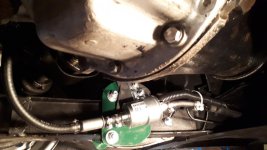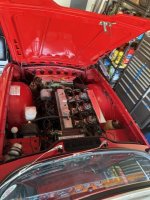Online
Love long posts! Thanks. Always good to learn. About the vacuum advance, yes, I need to check mine. Symptoms are all the same. I feel I’m dialing this stuff in step by step.Hi All
I have been lurking on this post. My few (OK a lot) thoughts on this are that the fuel is boiling in the float bowls. This happened to me on the hottest days when stuck in stop & good traffic or long stop lights. If so,
My car is stock with the original TR4A metal 4-blade fan. I do not want to mess with heat shields. If I suffer issues with boiling fuel (on the hottest days stuck in traffic) due to high under hood temps, I do two things: 1) I pop the TR4A hood/bonnet to give the hot air somewhere to vent, 2) pull my fast idle/choke knob and bring the idle up to 1200 RPM - I stop before the chokes engage. This move more air, speeds the water pump and also pushes more fuel so it has less time to absorb the heat. Once the car is back underway, I can easily reach around the windshield, lift the hood from the corner and drop to re-latch it.
- Today's gas, although much higher quality, boils at a lower temp than 1960's gas
- This is measured in Reid Vapor Pressure. The higher the RVP the easier it boils
- Adding ethanol and removing lead have raised the RVP. Ethanol free gas is not available in CT (except for race fuel at ~$10/gal)
- Octane does not affect RVP
- But, I am told, different brands of gas can have different RVP (i.e. Exxon vs Chevron vs Shell, etc). Try switching brands
- "Winter" blend fuel (sold here in CT from October to May) has increased RVP to improve cold weather starts. The gas compannies do this by adding more butane. If you don't drive many miles and have a tank of winter blend fuel in the car come June/July, it will spell trouble
- I add 3oz of Marvel Mystery Oil at each fill up as a cylinder top lubricant but, am told it also lowers RVP
- I have added float bowl "koozies" to my carbs, as available from Joe Curto (not on website, you have to call him)
- I have added heat shield to my fuel lines
This has resolved the issue for me in 99% cases. Next steps, if I ever want to keep going on this are: a) adding a TR6 engine driven fan (I have both the 8-blade yellow and 13-blade red) and b) rebuilding my distributor vacuum advance. I suspect my ignition timing is not advancing as it should at idle (when engine is under high vacuum). That leads to late ignition timing and increased exhaust manifold temp (and thus, increased under hood temps right at the carbs).
Sorry for the long post
Bob

 Hi Guest!
Hi Guest!

 smilie in place of the real @
smilie in place of the real @
 Pretty Please - add it to our Events forum(s) and add to the calendar! >>
Pretty Please - add it to our Events forum(s) and add to the calendar! >> 



